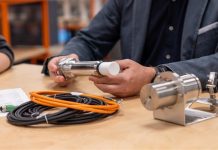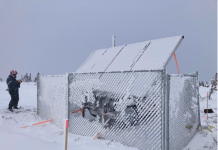Moog, a designer and manufacturer of high-performance motion control products and solutions, has earned a safety certification from TÜV Rheinland for the new Moog Pitch Servo Drive 3.
TÜV Rheinland is a global testing service provider and specialist for functional safety. Moog’s new Pitch System 3 is responsible for guaranteeing the safe operation of wind turbines. The feathering safety function supplied by the Moog Pitch System 3 Servo Drive alters a wind turbine’s blade pitch at the rotor hub to minimize the torque applied by the wind, avoiding excessive speed of the turbine. As a result, the pitch servo drive is classified as a safety component.
“The safety built into Moog Pitch System 3 helps wind-farm operators in three important ways,” said Dr. Tobias Theopold, technology development manager business unit wind for Moog. “The technology avoids hazards from the wind turbine and therefore lowers the insurance fees for wind-farm operators. As the safety-related development of Moog Pitch System 3 required an IEC 61508 and 13849 compliant V-model process including intensive failure insertion testing, this also boosts reliability of the overall product, which of course lowers downtime and reduces the levelized cost of energy.”
Moog established the benchmark for safety with its previous versions of the Moog Pitch Servo Drive when they were certified by TÜV Rheinland in 2012. With the Moog Pitch Servo Drive 3, Moog has received independent validation that this product also will perform outside the specification at extreme environmental conditions and in cases of unexpected failure.
%%1217-Moog%%
Along with certifying the safety of its new servo drive, Moog improved the architecture of Pitch System 3 to meet IEC 61508 and ISO 13849, standards governing wind-turbine safety. First, Moog’s engineers provide a safety function referred to as Safe Feathering Run (SFR), which automatically moves and stops a turbine’s blades in the feathering position. Second, Moog included a Safe Stop function called STOP1 to arrest the motion of an individual blade during manual movement of the blades. The Safe Stop function meets the ISO 13849 standard that addresses the requirements that blades must not perform an unintended move when people are working inside the wind turbine’s hub.
“To protect a wind turbine against overvoltage from the grid and lightning strikes, we included a new component called the Moog Pitch Interface Module,” Theopold said. “Our new interface module is a firewall to protect the blades against extreme environmental conditions and so-called common cause failures (CCFs). These failures are most critical because they can affect each of the pitch axes and therefore can put turbine safety at risk.”
Moog also asked lightning protection specialist DEHN to test Pitch System 3 (including its servo drive and interface module) inside a high voltage lab, subjecting the system to multiple lightning strikes reaching more than 260,000 amps. Afterward, the system was still fully operational and performed a Safe Feathering Run.
Source: Moog
For more information, go to www.moog.com



























